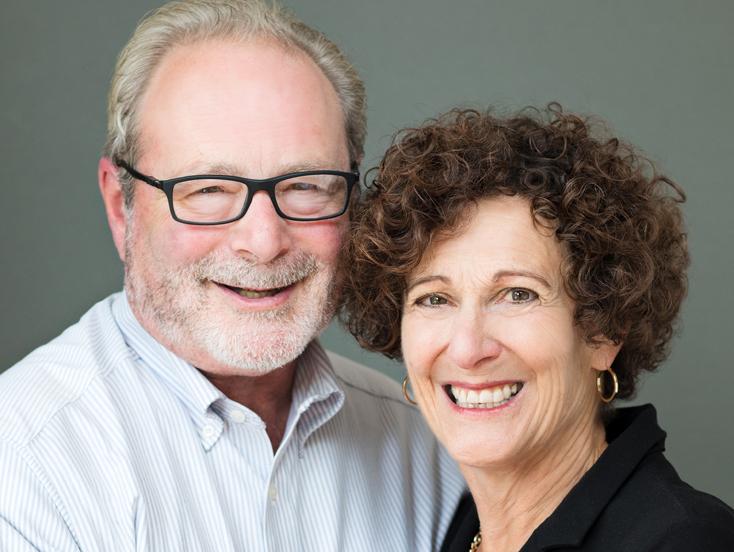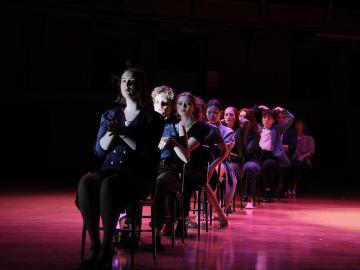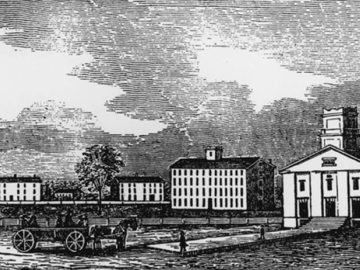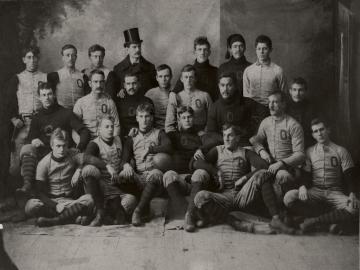Campus News
Elusive Equality: A Conversation with Carol Lasser and Gary Kornblith
May 9, 2019
Rebekkah Rubin ’13

Carol Lasser and Gary Kornblith, emeriti professors of history at Oberlin, released in December their book, Elusive Utopia: The Struggle for Racial Equality in Oberlin, Ohio, an account of Oberlin—town and gown—and the rise and fall of an idealistic vision.
Public historian Rebekkah Rubin ’13 talked to them about their findings. A condensed and edited version of this Q&A will be available in the spring 2019 issue of the Oberlin Alumni Magazine.
Rebekkah Rubin: Did Oberlin’s commitment to racial equality change over time, and if so, how? And did Oberlin differ from the rest of the country in that regard?
Carol Lasser: Well, that’s the heart of the book, isn’t it? Oberlin changes. The people who make up Oberlin change, and their understanding of their relationship to racial equality changes. The interesting thing for us, I think, has been that in the beginning, Oberlin is quite different from the rest of the country and utterly willing to stand up for the ways in which it is committed to radical racial egalitarianism, and I think part of that is the strength of the Christian belief. I think part of that is the strength of the abolitionist movement, which is gaining in intensity in the 1850s. After the Civil War, Oberlin needs to reevaluate its raison d’être, and it pulls back from that commitment to radical racial egalitarianism. Part of that may be a sense that emancipation has been achieved, so if the fight is against slavery, slavery has been eliminated. Over time, the people who have come to inhabit the town do not any longer see that the job of eliminating prejudice falls to them, so in that sense, they fall very much in line with other parts of the country and by the turn of the century you see segregationist practices, discriminatory practices, a color line having an impact even in Oberlin. They do not resist the outside world as they had once resisted it.
Gary Kornblith: The three objects of the Oberlin Anti-Slavery Society are “the immediate emancipation of the whole colored race within the United States, the emancipation of the slave from the oppression of the master, the emancipation of the free colored man from the oppression of public sentiment, and the elevation of both to an intellectual moral and political equality with the white.” I would just say two things: one is to recognize that there are really two foundings of Oberlin and its communal or utopian vision. One is the first founding when the colony is created in 1833 and the settlers arrive and they sign the covenant. The second is the re-founding, if you will, in 1835 after the so-called Lane Rebels—these abolitionists who had been studying at Lane Theological Seminary in Cincinnati, but who have left that institution because it objects to their abolitionist activities—come to Oberlin at [John] Shipherd’s urging and as part of a larger agreement. Initially, many of the existing settlers at the time and students are against the idea of admitting blacks, which is one of the conditions that the Lane Rebels establish. Shipherd is very much in favor of this, and it carries narrowly in the Board of Trustees meeting in February of 1835.
By the time that Charles Grandison Finney arrives as the first professor of theology and Asa Mahan as the first president, the mood within Oberlin has shifted. In the summer of 1835, there is a great antislavery revival, for lack of a better term—they don’t call it that—and the founding of the Oberlin Anti-Slavery Society. At that time, the townspeople do testify that they embrace these egalitarian principles; racial equality as well as the elimination of chattel slavery become central to the town’s identities, not just the college’s. Much of our book is more about the town than the college, though of course they’re intertwined. As Carol said, there is no real debate between those two goals, although there’s always a debate over means leading up to the Civil War. After the Civil War, and more particularly after the achievement of supposedly race-blind suffrage, many Oberlinians believed that the goals that were originally set had been achieved but it’s also true that by 1870, only a small minority of the residents of the town actually can remember the original events or even the famous Oberlin-Wellington Rescue.
CL: There’s a kind of amnesia and a supplanting of the original vision.
GK: But the original vision also has its weaknesses and that becomes more clear—
CL: That is that third plank: in a community committed to the elevation of black people to a white standard—that is not exactly how we would understand cultural diversity today. There are some presumptions of the superiority of whiteness that actually carry on and undermine racial equality in the later parts of the 19th and into the 20th century.
GK: Building on that, one of the key things to realize is there is no notion of culture in the 1830s. There is a notion of character, but not one of culture. What sets Oberlin apart from the rest American society, North as well as South, is a firm belief in the natural equality of blacks and whites. Beyond that, the white notion of equality is finding your way into the Kingdom of Christ, and they expect that everyone, once they’ve been able to shed the manacles of oppression, will, as free agents, be able to do this. In the end, it turns out that not everyone has the same notion of what the Kingdom of Christ will be, and the unselfconscious assumption that the white standard is the highest standard—not because whites are naturally better, but because they are better educated and they found their way to Christ—all of that becomes more complicated. But even in the early 20th century, Oberlin whites are not able to accept the notion of culture. They begin to see blacks as naturally different, so they’re more inclined to all of these things that today we would say are either white supremacists’ condescending stereotypes or the consequence of cultural diversity and that should be respected.
RR: You assert in the book that Oberlinians originally believed that the goal of abolishing slavery and eliminating prejudice could only happen through “peaceful and lawful means,” including “approaching the minds of slaveholders with the truth, in the spirit of the Gospel” and “concentrating public sentiment against the system” but then, in a space of a generation, you write they “forsook their faith in the efficacy of peaceful methods and embraced the use of coercive force to end human bondage.” What would you attribute this change to?
CL: There are several things going on but what’s particular to Oberlin is a mobilized black leadership group, many of whom have come recently from the American South, who have seen the violence of slavery perpetrated on slaves and who are themselves respected pillars of the community and are able to push their white neighbors to recognize, in a significant way, the ongoing violence of slavery. There is a radicalization in the larger abolitionist movement between 1850, with the passage of the Fugitive Slave Act, and 1861, when war breaks out, but what is, again, unique to Oberlin is the leadership of this group of mobilized black—and it is men—black men, who are able to in some ways reach their white neighbors about the need for action.
GK: But even in Oberlin, you do have blacks elected to the city council on a regular basis from the 1870s ‘til roughly 1912, although there is a break, and while [John Mercer] Langston himself had been elected too, as town clerk, it’s not until after the Civil War that you see blacks elected, but you see whites increasingly condescending in their attitude toward blacks.
GK: After the Civil War, there’s also no longer the migration to Oberlin of whites motivated by abolitionism, and even motivated by a sense of the urgency of preparing for the Second Coming—that dynamic shifts—so the kinds of white people who are moving to Oberlin is different after the Civil War. But there’s also one other aspect to all of this, in terms of the experience of living together in the Cuyahoga County Jail [following the Oberlin-Wellington Rescue], for some of the white leaders is also, I think, important to their acceptance—
CL: Radicalization.
GK: Of the need for, not only civil disobedience, but potentially violence. For someone like Henry Peck, who is an avowed abolitionist when he first shows up in Oberlin—he’s from the Rochester area—and he’s in that jail, and that matters to him, but he also is dead by 1865.
RR: You write that Oberlin’s temperance crusade promoted the “stigmatization of race”—can you tell me a little bit more about that?
CL: I think that the historians writing on the temperance movement today have been struggling with how to understand it as well. Again, Bill Bigglestone, more than three decades ago, recognized that after black emancipation, temperance was the movement that, in a sense, sucked up all the oxygen in Oberlin. His notion, at that point, was that it replaced black equality as the cause. I think we go further than that in trying to talk about how it really changed an understanding of race. The basic formula that I think we suggest is that antislavery never blames the slave; it blames the trafficker in slavery and it blames the enslaver. Temperance sees the sin of intemperance as one which good characters will rise above and drink at all, it turns out, becomes a way in which people become less able to save themselves and it becomes a character flaw. Poor black people bear the brunt of the temperance movement. It is an intolerant movement; it is an absolutist movement that in some ways plays into the worst stigmatization of race that we could imagine.
GK: One has to recognize that much of the impulse that drove abolitionism is essentially the same absolutist, moralist, self-righteous impulse that drives temperance. Even though we would disagree with the equation of the sin of slavery and intemperance and, certainly, we would disagree with the idea that you blame the drunkard for his or her plight in the way that they did, they had initially said “just say no” to slavery and now they were saying “just say no” to drink.
RR: Let’s talk a little about the creation of the color line in Oberlin, which I think most people would find a surprising reversal of Oberlinians’ earlier commitment to racial equality. How exactly would you say that the color line came about and how did it manifest itself?
GK: First of all, you can define the color line in different ways. It’s a term that only comes into use in the late 19th century; you don’t find that term applied before the Civil War. There were already, say in housing and in church membership—you didn’t have a black church but you had much lower participation of blacks in the Congregational church, which was for 30 years the only church in Oberlin among blacks and among whites—so there were already differences. There was some overconcentration of African Americans in the southeast quadrant but we established through statistical analysis that the extent of residential segregation—de facto now, not de jure—in Oberlin was rather low in 1860, certainly by comparison to other communities in the United States, and it rises over the next half century rather significantly. The place is never perfect, but after the Civil War, the difference in experience and behavior grows. I would say, especially whereas the black poor had never been fully included in certain kinds of community activities, they were not seen as the black community, and increasingly whites see them as the black community by the late 19th century and want to have less to do with them. There were many fewer bridge figures in the community—there were still a couple, but no one of the kind of John Mercer Langston. Even in the public schools, which had been integrated from the start and are still integrated in the early 20th century, you see increasingly an assumption that only whites will go on to professional careers, only whites will go on to college; blacks should move into vocational training. Then you have, in 1912 or 1913, the Hollywood addition, in which it’s made explicit that people moving to this new area of town, that it will be whites only. The college, likewise, wants to segregate its housing and basically says it’s not our problem when black athletes traveling to other colleges are told that they can’t stay in the same hotels as the white players, the college says “We didn’t do it.“
You also end up with an all-white city council after decades of having an integrated city council. You have no closing of the wealth gap and you have the acceptance, if you will, of black poverty as a natural fact, nothing that we can do about it, and that is very different from the earlier attitude. It’s not that black poverty didn’t exist in Oberlin, because it certainly did, but there was a sense, an expectation, that poverty would end when the prejudice rooted in slavery ended, but that prejudice didn’t end, it became worse, and Oberlin whites essentially said, well, we’ve done our thing and moved on. The black Oberlin leadership group tried different strategies to combat that, including inviting the Niagara movement [a civil rights organization founded by DuBois] to Oberlin but it was unable to push back successfully. The college starts accepting fewer black students, starts making sure that they’re in separate dorms, and the public schools, the elementary schools, are neighborhood-based but the neighborhoods are now increasingly racially separate—so is the school experience. We don’t have a full-scale Jim Crow regime, the town doesn’t have white versus colored drinking fountains, we don’t have lynching in Oberlin. Compared to some of what’s going on the United States, Oberlin is still a relatively safe space but it definitely is no longer committed to racial egalitarianism in a dramatic way. There’s no celebration of the 100th anniversary of the Oberlin-Wellington Rescue, but by the time you have the 150th, there’s a town celebration.
CL: None of this would be surprising in another town in Ohio; it’s only surprising because it’s Oberlin.
GK: It’s become Americanized.
CL: And because we are used to hearing the celebratory narrative. By the time you get to 1930, if you will, casual segregation is the rule and not the exception in Oberlin. By 1932-34, Oberlin is a segregated town. No one thinks about it. So, the rediscovery of civil rights activism, the rediscovery of inequality, the rediscovery of a commitment to radical racial egalitarianism in the ‘50s and ‘60s, or the ‘40s as we do in the epilogue—I mean, that’s the surprise, not that Oberlin succumbed, right? And we need to remember it’s a discontinuous history, right? We can’t just say, oh we have always stood for. It’s a struggle, it’s always a struggle, it’s a continuous struggle.
GK: It’s a reiterative struggle.
CL: Right, we can’t say, oh, solved that, done with that, racial equality achieved, checked that off my list—no.
RR: Even after the creation of the color line, you write about how, in 1919, the NAACP convention delegates came to Oberlin from Cleveland as a sort of pilgrimage, and you write that Oberlin still “enjoyed a special place in the imagination of racial progressives.” Do you think that Oberlin continues to occupy a similar place today?
CL: In the imaginary, yes. And hopefully, actually we continue to reflect on this and move forward in a way that becomes more racially inclusive, more cognizant of how our more recent heritage still makes for racial inequality in Oberlin, and it becomes our responsibility, the responsibility of those of us here now to think about ways in which the 21st century will continue to struggle against the inequalities that we see around us.
RR: Has researching and writing this book changed your perceptions of the town and the college?
CL: Wow, of course. Beyond that, of course.
GK: I have become more deeply knowledgeable, and as a result, respectful of, how difficult it has been throughout the town’s history to be an Oberlinian of color. That the profession by Oberlin whites of a kind of ethos of colorblindness actually, in certain ways, makes it harder, not easier when racist behavior arises because whites basically say, “No that’s not really racist but,” and the extent to which it’s a daily struggle—it’s not just these momentous occasions—which doesn’t mean that I’ve lived the experience of local African Americans. At the same time, Oberlin was founded as a perfectionist experiment, and I, like many Oberlin students, can be especially critical of its failure to achieve perfection, but we’ve discovered that we’re human. I think it is important that, at Oberlin, we still worry about it—you can go to lots of towns that were founded to be better than your ordinary communities who don’t worry about it at all. We still worry about it, we still hold ourselves, at least some of the time, to this higher law, if you will, for better and occasionally for worse. That, I think, is important and that, I think, is still part of the local culture, town, and college. We can be cynical about the failures of this place but it has bequeathed to later generations a certain idealism, notwithstanding the fact that these remain ideals and not practices in many respects, and that, I think, is rather remarkable, and that gives me genuine hope.
CL: I have this inchoate thought here which I’m going to try and put forward. Has it changed things? Yeah, also, all of what Gary said, I subscribe to that. Again, we are white people, we do not know the experience of people of color from the inside and I won’t pretend that we do, although we have a much greater appreciation for the meaning of that struggle on a day-to-day and on a generational basis. I’m just reflecting on the fact that we have our first president of color, living in a house on Forest Street, that real estate agent Louis Burgner would have had off-limits to her a hundred years ago.
GK: She doesn’t own it
CL: This is true. [laughs] But there is a kind of interesting irony about how things change and we are capable of change. Not every change has the intended consequences—Gary always says the only law in history is the law of unintended consequences—but there is a kind of interesting irony there, and a notion of change, of coming back to a set of aspirations that I hope continue to inspire us.
GK: You know, again the subtitle: the struggle for racial equality.
CL: There’s no end to the struggle.
Tags:
You may also like…
This Week in Photos: March 4
March 4, 2020
Alumni journalist and authors, the first black woman to stage an opera in the United States is honored, and TIMARA students who turn words of gratitude into works of audible art at a nearby hospital are just some of the features in this week’s photo series.
The Founding of Oberlin College
December 6, 2019
"In Oberlin History" is a series dedicated to notable events in Oberlin College history. In December of 1833, 29 men and 15 women began classes as the first students of the Oberlin Collegiate Institute.
The Unresolved Football Dispute with Michigan
November 24, 2019
In November 1892, the Oberlin College football team, coached by John Heisman, achieved an undefeated season when they beat the University of Michigan, 24-22. However, this game’s outcome is disputed to this day.


